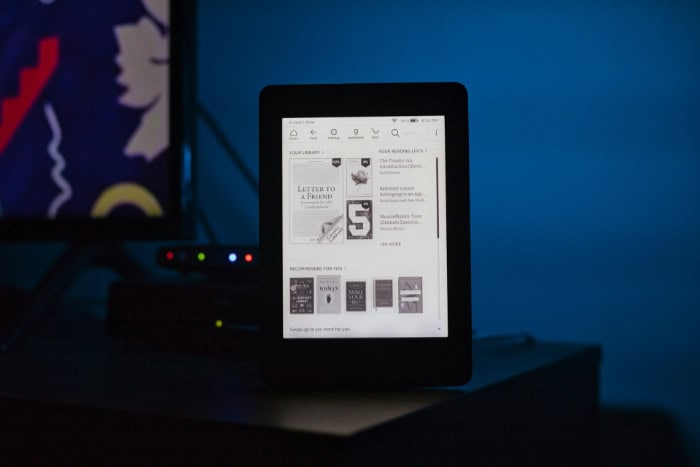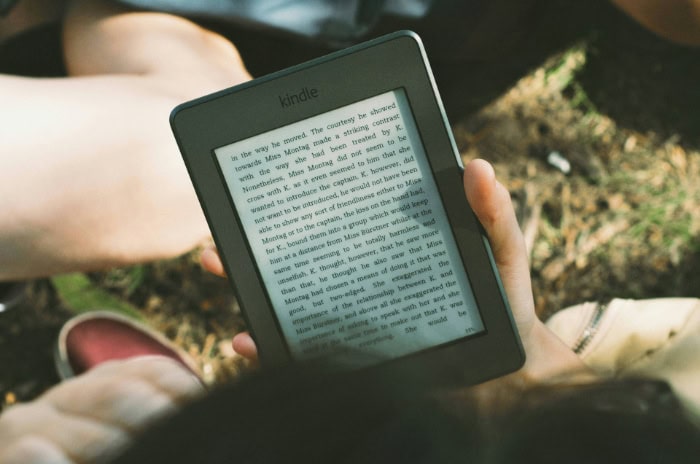What Is E-Ink? The Display That Looks Like Paper

Electronic ink, or E-Ink, has become a familiar presence in devices like e-readers, smartwatches, and even digital signs in stores. Its ability to mimic the look of paper, combined with exceptional power efficiency, has made it an appealing option for anyone looking to reduce eye strain or extend battery life.
Unlike traditional screens that emit light, E-Ink reflects it, offering a more comfortable viewing experience, especially in bright environments.
But there’s much more to this technology than meets the eye. From how it works at a microscopic level to the ways it’s being used in everything from wearables to retail, E-Ink is shaping the future of display technology in significant ways.
What Is E-Ink and How Does It Work?
At its most basic, E-Ink is a type of electrophoretic display technology. This means it uses tiny microcapsules filled with charged particles suspended in a clear fluid.
These capsules respond to electric fields, allowing the display to change the arrangement of particles and create readable text or images.
Unlike LCD or OLED screens, which need to refresh at high frequencies to maintain an image, E-Ink has a “bistable” nature. This means the display can hold an image without continuous power once it is set, only requiring energy when the content changes.
This characteristic makes E-Ink incredibly efficient for static content, such as the pages of a book or signage that doesn’t need frequent updates.
Technical Overview
The core of E-Ink technology lies in its electrophoretic microcapsules. Each microcapsule contains tiny particles of pigment that are either positively or negatively charged.
For traditional black-and-white displays, the microcapsules are filled with black and white particles. When an electric field is applied to a specific area of the display, the particles with the corresponding charge move either to the top or bottom of the capsule.
For instance, if white particles are drawn to the surface, that part of the screen appears white; if black particles are drawn to the surface, it appears black.
This process works across the entire screen, allowing images or text to be formed by controlling which particles are visible.
Because the particles are suspended in a clear liquid, light from the surrounding environment reflects off the surface, giving E-Ink its distinctive paper-like appearance.
While the traditional version of E-Ink is monochrome, newer iterations have introduced color capabilities. These displays use additional colored particles or filters to produce a limited color palette, though they are generally not as vibrant as traditional LCD or OLED screens.
Power Consumption
One of E-Ink’s most notable advantages is its bistable nature, which drastically reduces power consumption.
Unlike LCD or OLED displays, which require constant refreshing to maintain an image (and therefore continuously draw power), an E-Ink screen only uses power when the display content changes.
For example, when you turn a page on an e-reader, power is used to update the screen, but once the new page is displayed, no additional energy is needed to keep it visible.
This low power consumption makes E-Ink technology particularly suitable for devices that prioritize long battery life. E-readers, for instance, can last weeks on a single charge, as they only use power when flipping between pages.
Similarly, digital signs and shelf labels that don’t need to refresh frequently can run for extended periods without consuming much energy, making E-Ink a cost-effective and environmentally friendly option for many applications.
Applications of E-Ink Technology

E-Ink technology has found its way into a variety of products, largely thanks to its unique characteristics, such as low power consumption and exceptional outdoor readability.
From e-readers to digital signage and even wearables, E-Ink’s ability to display static images for long periods without needing a power source has made it an attractive choice for many industries.
E-Readers
Perhaps the most well-known application of E-Ink is in e-readers, such as the Amazon Kindle, Kobo, and PocketBook devices. These gadgets have gained widespread popularity because they offer a reading experience that closely mimics traditional paper books.
Unlike the bright, sometimes harsh, backlighting of LCD or OLED screens, E-Ink displays are reflective, meaning they rely on ambient light to make the text visible.
This results in a much more comfortable reading experience, especially for long periods, as it reduces eye strain and glare.
Another significant advantage of E-Ink in e-readers is the extremely low power consumption. Because the technology only uses power when changing the display (for instance, turning a page), e-readers can last for weeks or even months on a single charge.
This is a huge benefit for readers who travel or simply don’t want the hassle of charging their devices frequently.
The combination of a paper-like reading experience and exceptional battery life has made E-Ink the preferred display technology for e-readers, making them the go-to device for book lovers worldwide.
Digital Signage and Labels
Another growing application for E-Ink technology is in digital signage, particularly in retail environments. Electronic shelf labels (ESLs) and digital price tags are becoming increasingly common as stores look for ways to streamline operations and reduce their environmental impact.
E-Ink displays allow retailers to update pricing and product information remotely, eliminating the need for paper labels and reducing the time and labor required to manually change shelf tags.
For businesses, this offers several advantages. First, E-Ink’s bistable nature ensures that the displays consume almost no power once the information has been updated, making them a cost-efficient solution.
Second, the ability to update content remotely means that stores can adjust prices in real-time, whether it’s to reflect promotions, stock levels, or market conditions. This kind of flexibility can significantly improve inventory management and customer satisfaction.
Additionally, by reducing the need for printed materials, E-Ink digital signage helps retailers cut down on paper waste, contributing to sustainability efforts.
Beyond retail, E-Ink displays are also used in transportation hubs, such as train stations or airports, where schedules and information need to be updated regularly.
Their high visibility in direct sunlight and low energy consumption make them an ideal fit for these environments.
Wearables and Mobile Devices
E-Ink technology has also made its way into wearables and mobile devices, although it is less common in these areas compared to e-readers and signage.
Smartwatches with E-Ink displays, such as those by companies like Pebble, offer users a longer battery life compared to their LCD or OLED counterparts.
The reflective nature of E-Ink screens also makes them highly readable in outdoor settings, where traditional screens might struggle with glare.
One of the more innovative uses of E-Ink in mobile devices was the YotaPhone, a smartphone that featured both an LCD screen on one side and an E-Ink screen on the other.
The E-Ink display was perfect for reading texts, emails, and notifications without draining the battery, while the LCD screen offered the full-color experience necessary for apps, videos, and games.
By balancing the power-hungry LCD with the power-saving E-Ink, the YotaPhone demonstrated how the two technologies could complement each other.
While E-Ink wearables and mobile devices haven’t become as widespread as e-readers, they offer distinct advantages in terms of battery life and outdoor readability.
As consumers continue to seek devices that last longer between charges, there’s potential for E-Ink to play a greater role in the wearables and mobile market in the future.
Key Benefits of E-Ink Displays

E-Ink displays offer several advantages that make them suitable for specific applications, particularly where energy efficiency, readability, and eye health are important.
Energy Efficiency
One of the most significant advantages of E-Ink displays is their exceptional energy efficiency. This is largely due to their bistable nature, which means that the display only consumes power when the image or text on the screen changes.
Once the content is displayed, it remains visible without drawing additional energy. In contrast, LCD and OLED screens require continuous power to maintain an image, as they rely on backlighting or light-emitting diodes to keep the pixels illuminated.
For devices like e-readers, this low power consumption translates to extended battery life. An e-reader with an E-Ink display can last for weeks or even months on a single charge, compared to a few hours or days for devices using traditional display technologies.
This makes E-Ink a practical choice for products that don’t need frequent updates to the display, such as digital signs or e-readers where the content remains static for long periods.
In comparison, LCD and OLED screens are much more power-hungry because they need constant refreshing, even when the image on the screen is static.
This continuous need for power not only drains the battery faster but also generates more heat, which can affect the overall efficiency and longevity of the device.
E-Ink’s ability to maintain images without ongoing power is one of its most compelling benefits in energy-conscious applications.
Readability in Bright Light
Another major benefit of E-Ink displays is their superior readability in bright light. Traditional screens like LCD and OLED rely on light emitted from the screen itself, which can make them difficult to read in direct sunlight or brightly lit environments due to glare and reflections.
E-Ink, on the other hand, is a reflective display technology, meaning it uses ambient light to make the screen visible.
This quality is similar to how printed paper works, which is why E-Ink is often described as offering a “paper-like” reading experience. The display doesn’t generate its own light; instead, it reflects the surrounding light, making it easier to read in bright conditions.
This reflective property makes E-Ink particularly well-suited for outdoor use, where traditional displays might struggle with visibility.
Moreover, E-Ink displays typically have little to no glare, further enhancing their usability in bright environments. For anyone who has tried to read a smartphone screen under direct sunlight, the difference is immediately noticeable.
The lack of backlighting also means that E-Ink screens are gentler on the eyes, especially during prolonged reading sessions where glare and bright light can cause discomfort.
Eye Health
E-Ink displays are also beneficial for eye health, particularly when compared to LCD and OLED screens. One of the primary reasons for this is the reduced emission of blue light.
Blue light, emitted by most electronic devices, has been linked to eye strain and fatigue, especially when using screens for extended periods. LCD and OLED screens, which are backlit, emit significant amounts of blue light, which can be harsh on the eyes, especially in low-light conditions.
E-Ink displays, however, do not use traditional backlighting. Instead, they rely on ambient light to make the screen content visible, which significantly reduces the amount of blue light exposure.
This makes E-Ink an ideal option for e-readers and other devices that are used for long reading sessions. Readers can spend hours on an E-Ink device without experiencing the same level of eye strain that might occur with backlit screens.
Additionally, because E-Ink mimics the look of printed text, it feels more natural to read, much like reading from a book or magazine. This is particularly important for people who spend a lot of time reading, whether for work or leisure.
The reduced strain on the eyes, combined with the paper-like display, creates a more comfortable and sustainable reading experience, which is one of the reasons e-readers have become so popular.
Challenges and Limitations

While E-Ink technology offers several advantages, such as low power consumption and excellent readability in bright light, it is not without its limitations. These drawbacks affect its overall versatility and restrict its application in certain areas of the tech industry.
Slow Refresh Rates
One of the most significant limitations of E-Ink displays is their relatively slow refresh rate. Unlike LCD or OLED screens, which can update images and videos rapidly, E-Ink technology is not built for fast-moving content.
The time it takes for the charged pigments in the microcapsules to rearrange themselves is much slower than the speed required for smooth video playback or interactive graphics.
This delay makes E-Ink unsuitable for applications that require real-time responsiveness, such as gaming, video streaming, or even certain dynamic user interfaces.
Although some advancements have been made in speeding up refresh rates for tasks like page-turning on e-readers, the technology still lags far behind traditional displays when it comes to handling complex, fast-changing visuals.
This is one of the reasons why E-Ink remains predominantly used in devices designed for static or slow-changing content, such as e-readers, where the focus is on text and images rather than video or animation.
Limited Color Capabilities
E-Ink displays were originally developed in black-and-white, and while the technology has evolved to include color options, these advancements have been relatively modest.
Color E-Ink displays, such as the Kaleido series, offer a palette of colors but fall short in terms of vibrancy and clarity when compared to OLED or LCD screens.
The colors tend to appear more muted and less saturated, making these displays less suitable for media that requires high color fidelity, such as photo editing or graphic design.
The way color E-Ink works also contributes to its limitations. To produce color, E-Ink utilizes color filter arrays that sit on top of the traditional black-and-white E-Ink microcapsules.
While this allows for a range of colors, the color resolution and saturation are limited by the underlying technology. For instance, color E-Ink displays often have a lower resolution than their monochrome counterparts because the addition of color filters reduces the overall sharpness of the image.
As a result, color E-Ink is best suited for applications where color is helpful but not crucial, such as in digital signage or e-readers that occasionally display colored images or charts.
However, for tasks that require vibrant, dynamic, and high-resolution color images, traditional LCD or OLED displays remain the better option.
Cost Considerations
Another challenge with E-Ink displays is their relatively high production cost, especially when compared to more widespread display technologies like LCD and OLED.
While E-Ink’s low power consumption may offer long-term savings in certain applications, the initial cost of manufacturing these displays can be significantly higher.
This is particularly true for large or high-resolution E-Ink panels, where production complexities and material costs can drive up the price.
For businesses looking to adopt E-Ink for large-scale digital signage, the higher upfront investment can be a barrier.
Although E-Ink can save money in the long run through reduced energy use and lower maintenance costs, the initial expense can deter smaller companies or those with tight budgets from adopting the technology.
Similarly, for consumers, the higher cost of E-Ink devices, such as certain e-readers or specialty products like dual-screen smartphones, can make them less accessible compared to more affordable LCD or OLED devices.
Environmental Impact and Sustainability

E-Ink technology not only offers practical advantages in terms of readability and power efficiency, but it also contributes significantly to environmental sustainability.
The low power consumption of E-Ink displays, combined with their potential to reduce paper waste and extend device lifespans, makes them an eco-friendly alternative in a world increasingly conscious of its environmental footprint.
Energy Conservation
One of the primary ways E-Ink contributes to environmental sustainability is through its exceptionally low power consumption.
Traditional display technologies like LCD and OLED require constant power to maintain an image, as they rely on backlighting or self-emitting diodes.
E-Ink, however, only consumes power when the display content changes, meaning it uses no energy while displaying a static image. This characteristic makes E-Ink ideal for applications where the display remains unchanged for long periods, such as e-readers or digital signage.
Over time, this low energy usage can result in significant reductions in overall energy consumption, particularly in large-scale deployments like retail signage, public transportation displays, or other commercial applications.
For instance, electronic shelf labels in stores that use E-Ink technology can display prices and product information without needing frequent updates, drastically cutting down on electricity usage.
In a world where energy efficiency is becoming increasingly important, E-Ink’s minimal power requirements make it a sustainable choice for industries looking to reduce their carbon footprint.
Reduction in Paper Waste
Another major environmental benefit of E-Ink technology is its potential to reduce paper waste.
In retail environments, for example, electronic shelf labels (ESLs) and digital price tags can replace the traditional paper labels that need to be printed and manually updated whenever prices change.
This not only cuts down on the amount of paper used but also reduces the labor and time required to keep physical labels up to date.
Additionally, digital signage that employs E-Ink instead of traditional posters or printed materials helps businesses eliminate the need for constantly printing new signs or advertisements.
This is especially useful in industries such as retail, transportation, and hospitality, where information often needs to be updated regularly.
By replacing printed materials with digital alternatives, companies can significantly reduce their reliance on paper, which, in turn, helps decrease deforestation and the environmental impact associated with paper production and disposal.
In educational settings, E-Ink displays have also been used to create digital textbooks and note-taking devices, contributing to a reduction in printed materials.
Students and professionals can use E-Ink tablets to read, annotate, and store documents without the need for physical copies, further cutting down on paper usage.
Longevity and Durability
E-Ink displays are not only energy-efficient but also highly durable, contributing to longer device lifespans.
Unlike traditional screens, which can suffer from issues like burn-in (common in OLED displays) or require frequent backlight replacements (as with LCDs), E-Ink displays are more resistant to wear and tear.
They are often built with fewer fragile components, reducing the chances of hardware failure over time. This durability means that devices using E-Ink can last for several years without needing repairs or replacements, which reduces electronic waste.
Moreover, the reflective nature of E-Ink screens makes them less prone to damage from prolonged exposure to sunlight, which can degrade the quality of LCD or OLED displays over time.
This makes E-Ink particularly well-suited for outdoor applications like public signage or transportation schedules, where displays are exposed to various environmental conditions.
By extending the lifespan of devices and reducing the frequency of replacements, E-Ink technology helps minimize the environmental impact associated with manufacturing and disposing of electronic devices.
Fewer replacements mean fewer resources are needed to produce new devices, and less electronic waste ends up in landfills, contributing to a more sustainable technology ecosystem.
Conclusion
E-Ink technology has carved out a valuable niche in the world of display technologies, providing unique benefits that make it ideal for specific applications.
Its energy efficiency, paper-like readability, and reduced strain on the eyes have made it a popular choice for e-readers, while its ability to cut down on paper waste and conserve power has spurred adoption in retail signage and other industries.
However, the limitations in refresh rates, color capabilities, and production costs mean that E-Ink is not universally suited for all display needs.
Despite these challenges, E-Ink's contribution to sustainability and its potential for long-lasting, low-maintenance devices ensure that it remains a strong contender for applications where static content, energy conservation, and durability are prioritized.


